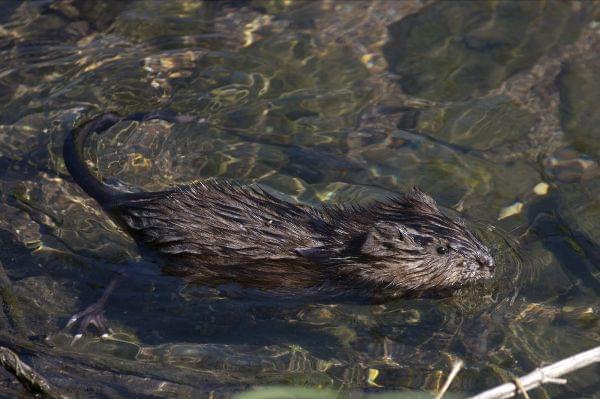Muskrat love?

A muskrat swims in the Boneyard Creek. Rob Kanter
By improving the way we treat our rivers and streams over the last half century, people in Illinois have enabled populations of many aquatic animals to rebound from twentieth-century lows. And by creating public spaces where waterways are a focal point, we’ve provided ourselves with opportunities to see aquatic wildlife on a regular basis—sometimes right in the center of town.
Take muskrats, for example, those dark brown creatures that remind people of beavers, except for their smaller size and less distinctive tail. Up until a few years ago, urban residents of Champaign-Urbana would have had to travel to see them. Not so anymore, since muskrats have thoroughly colonized the naturalized areas along the Boneyard Creek in Champaign on the University of Illinois campus.
Muskrats occupy a wide variety of aquatic and wetland habitats, including slow moving creeks, such as the Boneyard, marshes, swamps, ponds and lakes. They are native to North America, where their range extends all the way from Alaska and northern Canada to northern Mexico. They inhabit every county in Illinois.
Like most Prairie State muskrats, the ones that occupy the Boneyard Creek live in dens they excavate in the streambanks. The underwater entrances to the dens are not visible from shore, but their approximate location is evident from the mass of cut vegetation and disturbed streambed around it.
You may also be familiar with another type of muskrat home, the lodges built by muskrats that live in shallow, still water, which can often be seen in borrow pits along highways. These dome-shaped structures are made with aquatic vegetation and mud; they’re much like beaver lodges, but built on a smaller scale.
Muskrats are characterized by few of the things that writers and readers most enjoy in wildlife. At two to three pounds, and with a body about a foot long, they are neither big enough nor small enough to be remarkable. A muskrat’s scaly tail, which is about as long as its body, is flattened side to side and serves as a rudder. But it lacks the certain something that makes a beaver’s oversized, paddle-shaped tail a signature feature.
For my money, the most remarkable physical feature of muskrats is one we casual observers can’t actually see. It is lips that close behind the front teeth. This arrangement enables muskrats to chew submerged vegetation without taking in water.
As for what they can do, muskrats are pretty fast swimmers, with a top speed of about 3 miles an hour. But again, if you’re comparing, that’s less than half the top speed of a river otter. My sources all also mention that muskrats can swim backward, which must really be something to see, and they can reportedly stay underwater for 15 minutes.
Muskrats are also very good at making more muskrats, which enables populations to persist even under adverse conditions, and which serves the creatures that treat them as a resource. Among these are the many animals that eat them, with mink at the top of the list, and people who trap them for their pelts.
Unremarkable as muskrats may be as a species, I’m always glad to see them in town. It’s a reminder that a little accommodation can go a long way toward integrating the human and the natural worlds.

